Top 10 Patterns from Lake Chickamauga
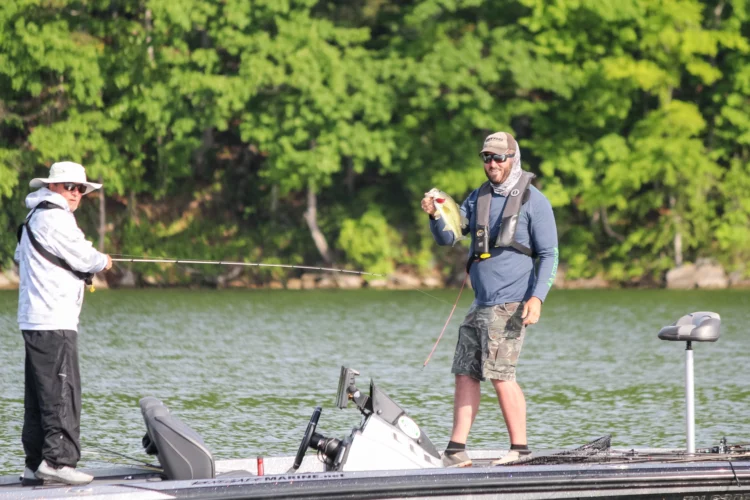
CHATTANOOGA, Tenn. – In a dramatic come-from-behind win, Matt Stanley jumped from 13th place on Day 2 all the way into first place on the third and final day of the Toyota Series Presented by A.R.E. Central Division event on Lake Chickamauga.
Stanley routinely fished an early-morning shad spawn pattern. On the final day, after having a tough time getting a bite, Stanley pulled out a Megabass Vision 110 (mat shad) jerkbait that he hadn’t thrown all week.
“I hadn’t used it in so long I had to dust it off before I tied it on,” Stanley said.
The jerkbait caught Stanley five bass—a 22-2 bag—on the final day, including a 9-pound beast. He beat out the Day 2 leader, Kevin Meunier, by 1-11.
Fishing for shallow water spawning bass was the primary pattern for most anglers. But varying weather conditions every day of the three-day event allowed a few anglers, like Stanley, to add in a few other recipes for success.
Here’s how the rest of the Top 10 caught their fish on Chickamauga.
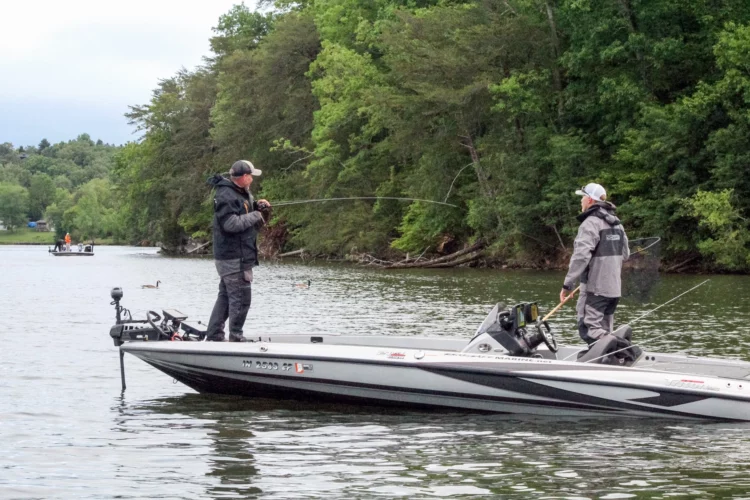
2. Meunier on a Consistent Spawning Bite
On Day 2, Kevin Meunier weighed in the largest bag of the tournament – five bass weighing 23-10. With cloudy, rainy conditions that day, most anglers felt like sight fishing spawning bass would be out of the question. Meunier proved them wrong.
He admitted that the shallow bass were almost impossible to see.
“I was just getting up shallow and running the banks until you see them dart off,” Meunier said. “Then I’d turn around and see if you could find them. They’d move back in, let them settle back down and go at ‘em.”
Meunier depended mostly on a weedless Freedom FT Structure jig with a Gambler Flappy Daddy trailer.
“Just getting it in their bed, they can’t stand it,” Meunier said. “It’s got rattles on it and a little BaitFuel (attractant) on it and it gets it done.”
Meunier prefers a natural-color pattern but sometimes when he was fishing a little deeper, he would switch to a white jig just so he could see it better.
“I don’t think it’s real particular,” Meunier said. “Sometimes they pick it up a hurry. Sometimes you’ve just got to go to moving it around and aggravating them. It can take five minutes and it can take 45 minutes. It’s all up to the fish.”
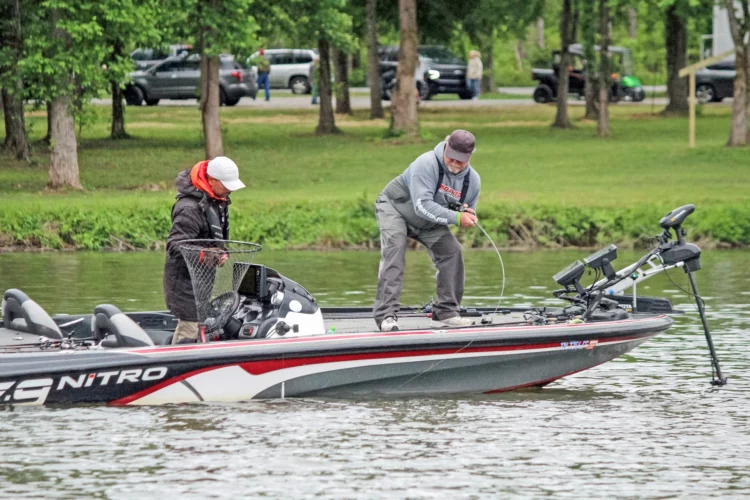
3. Brown Made the Long Haul
Tommy Brown consistently made one of the longest runs of the tournament, ultimately going 40 miles upriver each day to the area known as Old Washington.
The backwater area off the main river is 6-feet deep at the most, many areas much shallower.
“Everything has been shallow this week,” Brown said. “We should be getting into some post-spawn but it seems right now you just have to get shallower than shallow.”
In spite of fishing shallow, Brown was casting a 6.75-inch 3:16 Bait Company Rising Son in the top hook line thru version.
“Everybody is throwing little swimbaits,” Brown said. “You’ve got to throw something so they can see it.”
On the final day, however, Brown said the big swimbait wasn’t working.
“They would bump the bait but they wouldn’t eat it,” Brown said. “So, I started dragging around a Fluke or a Senko to get what I got.”
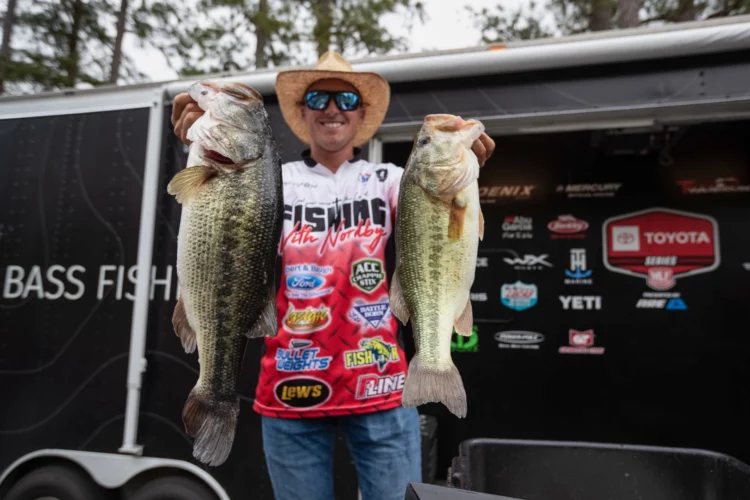
4. Nordbye Pulls out a Late Crankbait Bite
Andrew Nordbye said he had a different “favorite bait” each day of the tournament.
“Seriously, it was something different each day,” Nordbye said, who was fishing shallow most of the time.
But on the final day he said there was just enough current flowing to generate a little bit of a deep ledge bite, yielding his biggest bass of the week on a 6th Sense C25 crankbait.
“The fish were down there but they didn’t want to bite all week,” Nordbye said. “They started pulling current (the last day), the first time in eight days that I got them to eat a crankbait.”
Nordbye said he was getting that C25 down to 25- or 26-feet deep.
“I was throwing it as far as I could and cranking it as fast as I could,” Nordbye said. “I even long-lined a little bit.”
It’s illegal for tournament anglers to troll. But they can make an extremely long cast, then put their reel in free spool, hit the trolling motor and back off to release another 30, 60 or even 100 feet of line – long-lining. Then they start cranking and the extra line length allows the crankbait to get down into the strike zone and stay there longer.
“It’s slow fishing but it’s worth it,” said Nordbye.
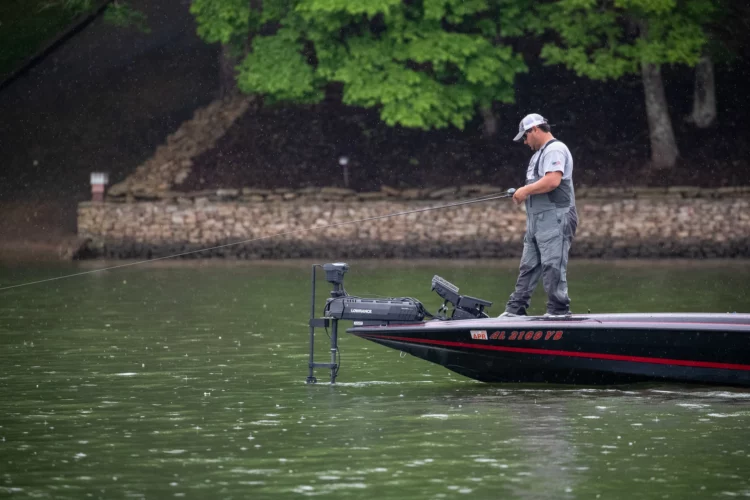
5. Nichols Starts on the Shad Spawn
Cody Nichols was the only angler who stayed consistently high in the standings all three days.
During his practice days, Nichols said he found a solid, early morning shad spawn bite he felt he could capitalize on. That inspired him to tie on a ½-ounce Z-Man/Evergreen ChatterBait Jack Hammer with a Reaction Innovations Skinny Dipper trailer. He said the pattern put at least a few fish in the livewell every morning, a major boost in the “confidence factor.”
After the morning shad bite died, he said he went running and basically junk fishing. He said when he left the shad spawn bite for the shallow bite, he preferred fishing a Reaction Innovations Sweet Beaver.
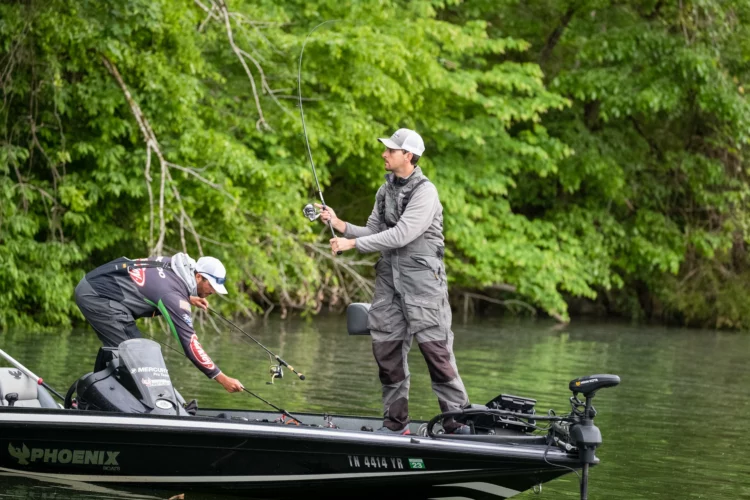
6. Drake Fishing His “Home Lake”
Kevin Drake lives in nearby Cleveland, Tennessee and routinely fishes Chickamauga. Watch nearly any of the winner lists in local tournaments and you will usually see Drake’s name among the leaders, if not on the very top.
He has fished enough big tournaments to know, however, that a home-field advantage doesn’t guarantee anything and consistency is always the key–especially when the lake has not been fishing quite as strong as it has in years past.
“Absolutely,” Drake said. “I felt from the beginning that consistent 15- or 16-pound bags would get you in the Top 10, the way the lake’s been fishing.”
He ended the tournament with 45-11, right at a 15-pound average each day.
Drake wasn’t fishing the ultra-shallow water like many anglers, but he was staying close. He said most of his fish came from 3-feet to 8-feet deep. He relied mostly on a Berkley PowerBait MaxScent The General, cinnamon purple color. He rigged it as a Neko rig, a variation of a wacky rig that uses a nail weight inserted into just one end of the worm.
“It gives it a little more action and it sinks a little bit faster,” Drake said. “I wasn’t fishing dirt shallow so I think that nail weight with a little faster rate of fall helped me a lot. I was just picking through every little piece of cover I could find.”
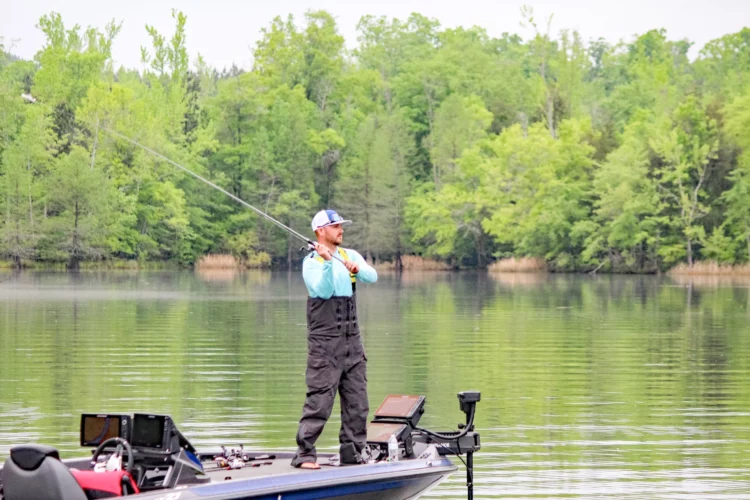
7. Reece Had Two Patterns
“I had two basic things going on this week,” Clay Reece said. “I had an offshore grass place that allowed me to catch a limit every morning really quick.”
After that, Reece followed the field, heading super shallow and sight fishing.
“The first day I culled up everything I had sight fishing,” Reece said.
However, really bad luck struck on Day 2 when his boat broke down around 10 a.m. and he was done for the day. Fortunately, his early “grass fish” limit, weighing 12-15, was enough to keep him in contention for the final day.
On the final day, conditions were poor for sight fishing.
“I’d burned through most of my spawners,” Drake admitted. “So, I went back to my grass in the afternoon and caught a couple of big ones.”
Reece was using his sonar to locate offshore grass beds that are still well below the surface. He said he was finding lots of grass, but that it wasn’t all created equal. He found one bed that had a hole in the middle of the grass and in the morning they would wad up in that hole.
“But they’re real educated on this lake,” Drake said. “When you catch a couple, they kind of disperse. I would take my trolling motor and go 100 yards away and throw the wacky rig around. And then I’d come back to them (in the hole) and I’d catch a couple more.”
Reece depended primarily on 5-inch Yamamoto Senko rigged wacky style.
“The first day I caught them on green pumpkin until I ran out,” said Reece. “They didn’t have them at the tackle shop so I just got one that looked green pumpkinish but I don’t even know what color it was.”
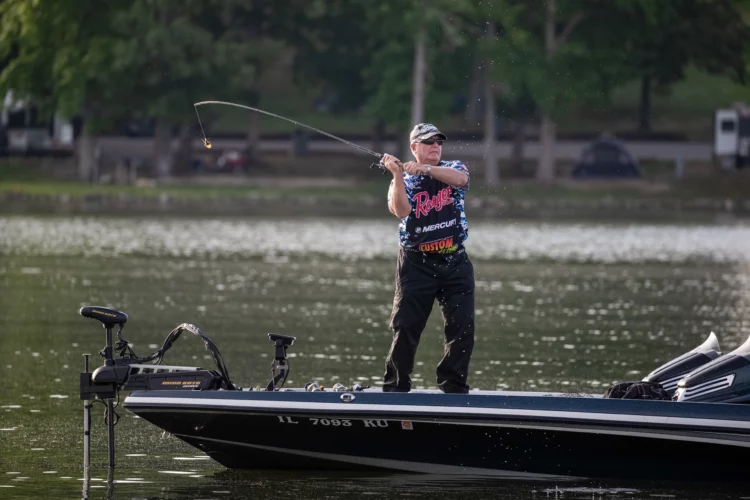
8. Black Saved a Lot on Gas
Michael Black fished very close to the Chester Frost Park takeoff spot.
“The first two days I didn’t burn a gallon of gas,” Black said with a smile.
He basically threw one lure consistently – a 7/16-ounce jig with green and orange as his go-to color combo. His jigs were homemade by a friend. On the final day, Black only brought four fish to the scales.
“The one time today that I had my fifth fish on I was throwing a shaky head and I lost the sucker,” Black said.
He spent most of the time casting into 5 to 10 feet of water.
“I was just dragging it all around [Dallas Bay] like a Carolina rig,” he said.
Black’s biggest fish came on Day 2 when he just had four basic keepers in the livewell.
“I kept praying for more and bigger,” he said. “At 1:30 the Good Lord helped me out with a 7-10 right there (pointing toward the water within sight of the weigh-in stand). It was a wonderful deal. We high-fived for ten minutes.”
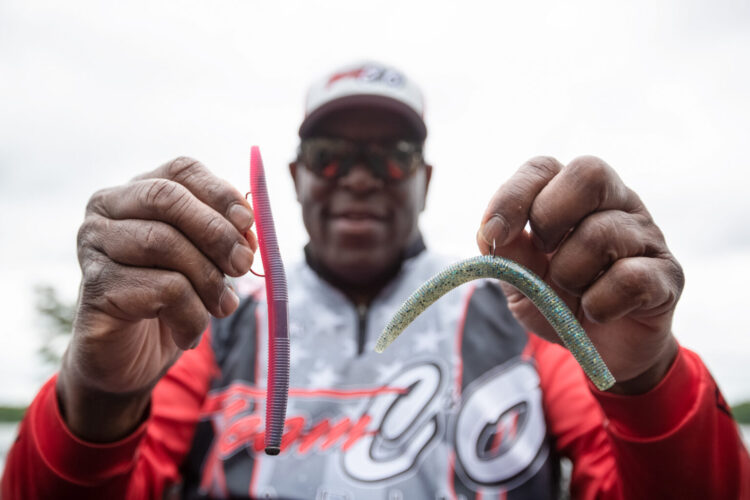
9. Gillespie Glad to be Back in the Money
Carl Gillespie has fished in 84 MLF events but admits it’s been a long time since he’s been in the good money.
“It’s been a while since I’ve been in a Top 10,” Gillespie said. “It’s been about five years, so I’m pretty excited. And I’m really surprised because you’ve got these heavy-hitters out here. All I did was just play to my strength.”
It was good timing because Gillespie says his strength is shallow water, the kind of water most top anglers keyed on this week.
Gillespie was fishing in the Armstrong Bend area of the lake, near Dayton.
“I was running 60 miles round trip every day,” he said.
However, Gillespie happened to find an area that very few anglers wanted to fish and had it virtually all to himself.
“I never got contested the whole three days I was there,” he said. “I didn’t run into another boater the whole time. I had it all to myself. I focused on cypress clumps and this hay grass (locally called marsh grass or sawgrass). I concentrated on those two. It seemed like they would kind of hold up around the cypress clumps and they would spawn on that hay grass.”
Gillespie said he wasn’t seeing the spawners, he was just working the areas.
“They got real aggressive (the last day),” Gillespie said. “I wish I could have had another hour out there.”
He relied on Bass Pro Shops Stik-O worm, a “Senko-style” bait either rigged as a basic wacky rig or Neko style, with a nail weight in one end. But rather than hooking the worm in the middle, he placed the hook on the opposite end of the worm from the nail weight which he said caused the lure to actually fall backward, back underneath the cover.
Morning dawn and bluegill were his favorite colors.
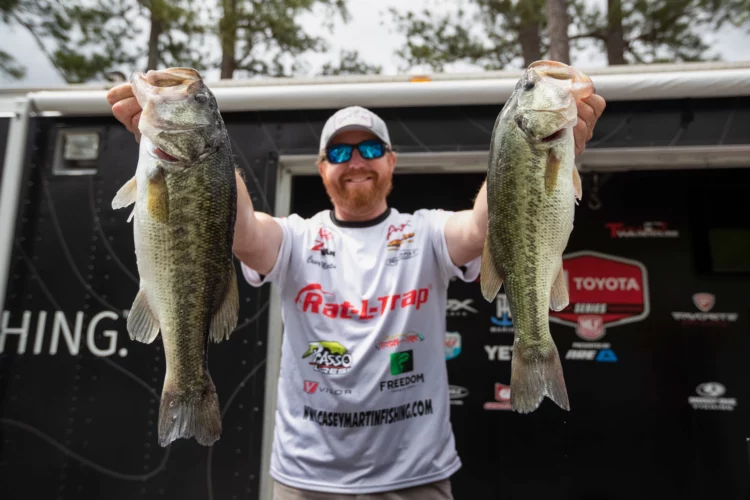
10. Martin Focused on the Shad Bite
Casey Martin found dead shad in his livewell about 3.5-inches long. Even though there was also a bluegill spawn underway, he was convinced the bass were definitely keyed in on shad – at least the ones he was catching.
“I was fishing shallow most of the time,” Martin said. “I was catching them around the reeds and the vine grass, stuff like that. They were spawning but I wasn’t necessarily looking at them. I did catch a few I saw, but for the most part I was just fishing around bedding areas that I knew from the past.”
He relied mostly on a Z-Man/Evergreen ChatterBait Jack Hammer with a Z-Man RaZor ShadZ trailer.
“I think it was more of a reaction bite,” Martin said. “A lot of guys were throwing Senkos and craws, beavers and stuff like that. I feel like I was picking the ones off that were focusing on shad. They were definitely shad-related. I never really saw a shad spawn but I know they were definitely feeding on shad.”